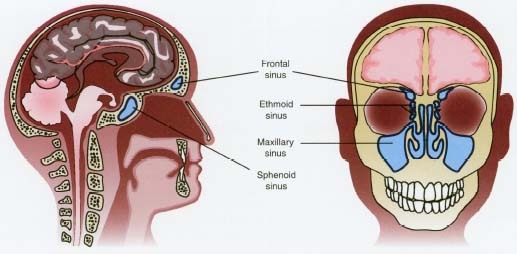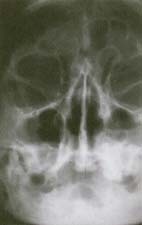Sinusitis
Sinusitis (sy-nyoo-SY-tis) is an inflammation of the sinuses (SY-nuh-ses), the hollow chambers or cavities located in the bones of the face that surround the nose.
KEYWORDS
for searching the Internet and other reference sources
Allergies
Asthma
Paranasal sinuses
Respiratory infections
Sinuses
Streptococcus pneumoniae
What Causes Sinusitis?
There are four pairs of paranasal sinuses (the sinuses surrounding the nose):
- The frontal sinuses are in the forehead and over the eyebrows.
- The ethmoid (ETH-moyd) sinuses are between the eyes at the bridge of the nose.
- The sphenoid (SFEE-noyd) sinuses are behind the ethmoid sinuses.
- The maxillary (MAX-ih-lary) sinuses are in the cheekbones.
* mucous membranes are the moist linings of the mouth, nose, eyes, and throat.
The sinuses and the narrow tube-like structures that link them to the nasal passages are lined with the same mucous membranes * that line the nose. Colds, allergies, and exposure to some chemicals can cause swelling and inflammation in the lining of the sinus passages and block sinus drainage. Bacteria (such as Streptococcus pneumoniae, strep-tuh-KAH-kus

People with allergies, asthma, and cystic fibrosis * are more likely to have sinus infections. So are people with a weakened immune system, such as those who have AIDS or cancer; people with narrow sinus passages or with growths or blockages in the nasal area, such as tumors or polyps * ; and people with previously broken or deformed nasal bones. The risk of sinusitis also is higher when people swim or dive, because of the pressure this activity puts on the sinus cavities.
Are There Different Types of Sinusitis?
Physicians classify sinusitis in three ways:
- Acute * sinusitis often develops after a person has had a cold, with symptoms lasting less than 3 weeks.
- Chronic * sinusitis can last 3 to 8 weeks or longer; it often occurs in people who have allergies or asthma.
- Recurrent sinusitis consists of several acute episodes of sinusitis in 1 year.
* cystic fibrosis (SIS-tik fy-BRO-sis) is a disease that causes the body to produce thick mucus that clogs passages in many of the body's organs, including the lungs.
* polyps (PAH-lips) are bumps or growths usually on the lining or surface of a body part (such as the nose or intestine). Their size can range from tiny to large enough to cause pain or obstruction. They may be harmless, but they also may be cancerous.
* acute describes an infection or other illness that comes on suddenly and usually does not last very long.
* chronic (KRAH-nik) means continuing for a long period of time.
How Common Is Sinusitis?
The National Institute of Allergy and Infectious Diseases estimates that every year 37 million people in the United States have sinusitis.
Is Sinusitis Contagious?
No one can catch a sinus infection from another person, but the viruses and bacteria that cause colds and other respiratory tract * infections that can trigger sinusitis may spread from person to person in drops of fluid from the nose or mouth. When people cough, sneeze, laugh, or talk, they can transmit germs to their hands, to the surfaces around them, and into the air. Other people can breathe in the germs or touch contaminated surfaces with their hands and spread the germs to their noses and mouths.

What Are the Symptoms of Sinusitis?
Symptoms of a cold (runny nose and low fever) often give way to pain and pressure in the sinuses, which are usually the first signs of sinusitis. Other symptoms include pain or puffiness around the eyes; a bad-smelling, yellow-green discharge from the nose; bad breath; a headache in the morning; aching in the upper jaw and the back teeth; weakness or extreme tiredness; and coughing, especially at night. People with sinusitis occasionally develop earaches, neck pain, or a sore throat caused by mucus * draining into the throat.
How Is Sinusitis Diagnosed?
Sinusitis is suspected if cold symptoms last for more than 10 days or if sinusitis symptoms are present. A doctor may order X rays or a computerized tomography * (CT) scan to determine whether the sinuses are inflamed.
How Is Sinusitis Treated?
Bacterial sinusitis usually clears up after treatment with antibiotics. There is no specific treatment for sinusitis caused by a virus. People can try to relieve the symptoms of sinusitis in several ways. They can take acetaminophen * to help ease the pain and use nonprescription decongestants (deekon-JES-tents), taken by mouth or in sprays, to lessen stuffiness. Using a decongestant nasal spray for more than a few days, however, may itself cause swelling of the sinuses and slow recovery. Saline or salt sprays also may reduce swelling in the sinuses. Placing a warm compress over the infected sinuses, using a steam vaporizer * , or sitting in a warm, steamy bathroom can help as well. Doctors may prescribe special nasal sprays or oral (by mouth) medications for people with chronic sinusitis who have allergies that contribute to the infection. In some cases, people with severe chronic sinusitis may undergo surgery to enlarge their sinus passages, to remove a polyp, or to fix a deviated septum * that might be blocking sinus drainage.
* respiratory tract includes the nose, mouth, throat, and lungs. It is the pathway through which air and gases are transported down into the lungs and back out of the body.
* mucus (MYOO-kus) is a thick, slippery substance that lines the insides of many body parts.
* computerized tomography (kom-PYOO-ter-ized toe-MAH-gruh-fee) or CT, also called computerized axial tomography (CAT), is a technique in which a machine takes many X rays of the body to create a three-dimensional picture.
* acetaminophen (uh-see-teh-MIH-noh-fen) is a medication commonly used to reduce fever and relieve pain.
How Long Will It Last?
Acute sinusitis usually clears up within 3 weeks, or within 1 to 2 weeks with treatment. Chronic sinusitis lasts 3 to 8 weeks or longer and may require longer courses of antibiotics and other treatments to resolve the condition.
Are There Complications?
Complications of sinusitis are rare, although they do occur. Sinusitis can cause osteomyelitis * when the infection from the sinus spreads into the bones of the face or skull, or it can lead to an infection of brain tissue or meningitis (inflammation of the meninges * ). A sinus infection also can spread to invade the tissues surrounding the eyes.
Can Sinusitis Be Prevented?
Because there is no practical way to prevent all colds or to eliminate all allergies, sinusitis is not entirely preventable. People can limit their exposure to the viruses and bacteria that cause the infections by washing their hands thoroughly and frequently and by not sharing eating or drinking utensils. Not smoking and avoiding exposure to tobacco smoke also can help limit the risk of sinusitis. It is wise for people with allergies to avoid the things that trigger their allergy symptoms and to control their allergies with the treatment recommended by their doctors. Drinking plenty of fluids and keeping the air in the house moist by using a vaporizer can help thin mucus and prevent its buildup in the sinuses. Limiting alcohol consumption also may help, because alcohol can cause nasal membranes to swell.
* vaporizer is a device that converts water (or a liquid medication) into a vapor, a suspension of tiny droplets that hang in the air and can be inhaled.
* deviated septum is a condition in which the wall of tissue between the nasal passages, the septum, divides the passageways unevenly, sometimes causing breathing difficulties and blockage of sinus drainage.
* osteomyelitis (ah-stee-o-my-uh-LYE-tis) is a bone infection that is usually caused by bacteria. It can involve any bone in the body, but it most commonly affects the long bones in the arms and legs.
* meninges (meh-NIN-jeez) are the membranes that enclose and protect the brain and the spinal cord.
Resources
Organization
National Institute of Allergy and Infectious Diseases (NIAID), Building
31, Room 7A-50, 31 Center Drive MSC 2520, Bethesda, MD 20892. The NIAID,
part of the National Institutes of Health, publishes pamphlets and a
fact sheet about sinusitis at its website, along with links to other
websites offering more information,
http://www.niaid.nih.gov
Comment about this article, ask questions, or add new information about this topic: